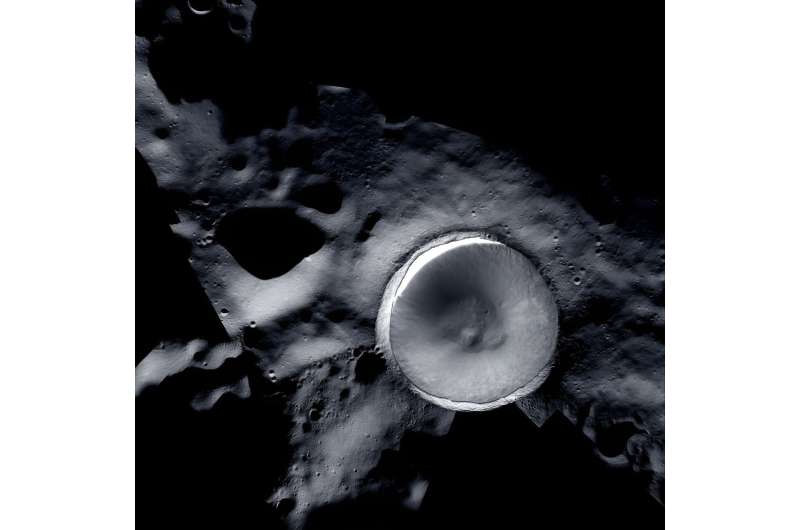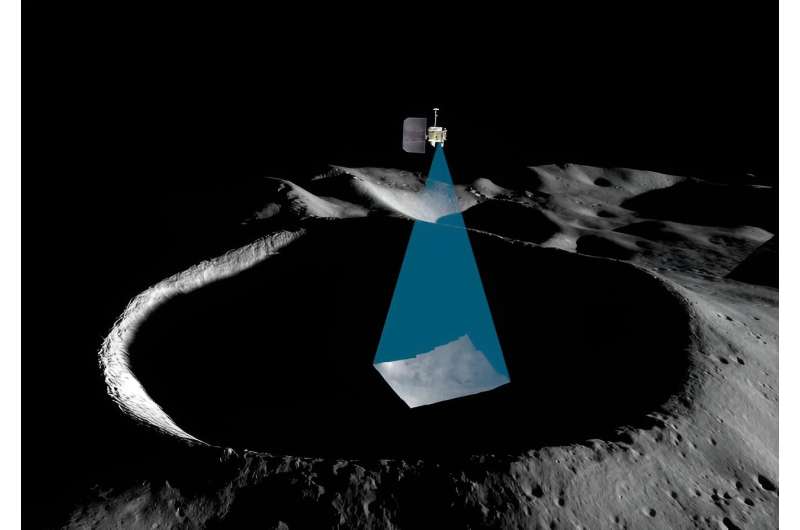This article has been reviewed according to Science X's editorial process and policies. Editors have highlighted the following attributes while ensuring the content's credibility:
fact-checked
peer-reviewed publication
trusted source
proofread
The darkest parts of the moon are revealed with NASA's new camera

While the surface of the moon has been mapped in incredible detail over the last several decades, one region has eluded orbital cameras due to the lack of sunlight, which are aptly called the permanently shadowed regions (PSRs) of the moon.
However, two cameras operating on two different lunar orbiters have recently worked in tandem to produce a stunning mosaic image of the lunar south pole's Shackleton Crater, a portion of which resides directly on the lunar south pole and whose depths have been shrouded in complete darkness for possibly the last few billion years.
As a result, scientists hypothesize that water ice could have accumulated within its dark depths that future astronauts could use for fuel and life support.
These two cameras are NASA's Lunar Reconnaissance Orbiter Camera (LROC) mounted on the Lunar Reconnaissance Orbiter (LRO), and NASA's ShadowCam that is mounted onboard the Korea Aerospace Research Institute's (KARI) Danuri spacecraft, with each spacecraft having been in lunar orbit since 2009 and 2022, respectively, and each camera providing their unique capabilities to help construct this unique and first-time mosaic image.
LROC features two narrow-angle cameras (NACs) capable of capturing images at 0.5 meters per pixel and a wide-angle camera (WAC) that can capture 100 meters per pixel, which is how LROC has delivered thousands of high-resolution images of the moon during its 13 years of service. Despite this, LROC is unable to take images that are not in direct sunlight.
Enter ShadowCam, whose light sensitivity is 200 times greater than LROC and can capture details of the lunar surface that have remained unseen until now. It accomplishes this by capturing the reflected sunlight from the myriad of geologic features on the moon or light from the Earth, also known as Earthshine.
The downside is ShadowCam can't capture images in direct sunlight, which is why images from both cameras were used to create this stunning mosaic, as ShadowCam was used to capture the unlit portions of Shackleton Crater, such as the interior walls and floor, and LROC was used to capture the sunlit portions, such as the flanks and rim of the crater.

The reason why scientists and engineers are so interested in Shackleton Crater and other lunar PSRs is due to their potential for possessing water ice that can be used for fuel and life support on future human missions, such as NASA's Artemis missions to the moon beginning with Artemis III, which is slated to be the first human landing on the lunar surface since Apollo 17 in 1972 and the first to the lunar south pole, and currently scheduled for 2025.
These PSRs exist in both the lunar north and south poles and exhibit craters that reside in permanent darkness due to the small 1.5-degree axial tilt of our nearest celestial neighbor. For context, the Earth's axial tilt is 23.5 degrees.
By directly mining water ice on the moon, also known as in situ resource utilization, this could substantially reduce the cost of resupply missions from the Earth, as water is arguably the most vital component of any crewed space mission. Additionally, since such water ice has allegedly been trapped in these craters for millions, if not billions, of years, they could also provide valuable scientific insights into the formation and evolution of the moon, as well.
Shackleton Crater is named after Sir Ernest Shackleton, who was an Anglo-Irish Antarctic explorer responsible for leading three British expeditions to the Antarctic. It is approximately 21 kilometers (13 miles) in diameter and 4.2 kilometers (2.6 miles) deep and was officially given its name in 1994 by the International Astronomical Union.
In terms of exploration, NASA's Lunar Prospector spacecraft identified high amounts of hydrogen near both lunar poles, including Shackleton, whose findings were published in a 1998 study in Science.
However, numerous studies since then, including radar images from NASA's Clementine and Japan's Kayuga spacecraft, did not reveal any evidence for water ice within Shackleton, and their findings were published in Icarus and Science, respectively. Thus, the debate for the existence of water ice within Shackleton remains open. As of 2019, there are 324 known PSRs on the moon.
Provided by Universe Today





















